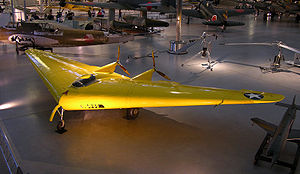Northrop N-1M Video - Planes of Fame Airshow
|
|
Northrop N-1M
N-1M

Picture - Northrop N-1M on display at the National Air and Space Museum's Steven F. Udvar-Hazy Center. Restored to its final flight configuration.
Role: Flying wing
Manufacturer: Northrop
Designed by: Jack Northrop
First flight: 3 July 1941
Retired: 1945
Status: Experimental
Primaryuser: Northrop Corp.
Number built: 1
Variants: Northrop N-9M
The Northrop N-1M "Jeep" was an early flying wing aircraft, predecessor to the Northrop N-9M and Northrop XB-35/YB-35 and YB-49 long-range bomber aircraft.
Design and development
Jack Northrop was involved in innovative all-wing designs in the late-1920s with his first designs flying in 1928-1930 period with the first prototype, the 1929 "Flying Wing" evolved from earlier design studies. The test aircraft was unusual in appearance with tail flying surfaces on twin booms and a fuselage and engine blended into the wing. It had adequate performance, but was more noted for its unique all-metal, stressed skin, multi-cellular construction. The "Flying Wing" (X-216H), was test flown in 1929 with Edward Bellande at controls. Northrop was also aware of Walter and Reimar Horten's pre-war record-setting "tailless" glider designs in Germany.
The N-1M was one of a progression of experimental aircraft that further developed Northrop's "flying wing" concepts. This aircraft, the first true flying wing produced in the United States, was developed during 1939 and 1940 as a flying testbed for the purpose of proving Jack Northrop's vision of a practical, all-wing aircraft. Built of wood, and designed to accept configuration changes, the diminutive test aircraft served its purpose well, first taking to the skies on 3 July 1941 at Baker Dry Lake in California.
Operational history
Northrop's Chief Test Pilot Vance Breese flew the N-1M on its maiden flight, unexpectedly bouncing in the air during a planned high speed taxi run. He reported that the aircraft could fly no higher than five ft off the ground. Flight could only be sustained by maintaining a precise angle of attack but Theodore von Kx¡rmx¡n solved the problem by making adjustments to the trailing edges of the elevons. Control of the aircraft was achieved through the use of a system of elevons and wing tip rudders. The elevons served in tailless type aircraft both as elevators and ailerons while split flaps on the drooping wingtips took the place of a conventional rudder. These wingtips originally drooped downward but were later straightened.
The flight test program continued with Moye W. Stephens, Northrop Test Pilot and Secretary to the Northrop Corporation, serving as a test pilot. Early tests showed the N-1M to be satisfactory in stability and control but overweight and underpowered. The aircraft's two 65hp Lycoming 0-145 four-cylinder engines (buried in the wing to reduce drag) were replaced by two 120hp six-cylinder 6AC264F2 air-cooled Franklin engines. By November 1941, after having made some 28 flights, Stephens reported that when attempting to move the N-1M about its vertical axis, the aircraft had a tendency to "Dutch roll." The oscillations proved to be manageable when adjustments were made to the aircraft's configuration.
The N-1M proved to be basically sound, paving the way for Northrop's later and much larger flying wing aircraft. The pioneering aircraft was donated to the United States Army Air Forces in 1945 and was then placed in the storage collection of the National Air Museum the following year. It sat there for nearly three decades. It was finally brought back to its final flight configuration in the 1980s after a couple of years of painstaking restoration. It was fully restored to a static, non-flying status. It is now on public display at the National Air and Space Museum's Steven F. Udvar-Hazy Center.
Specifications (N-1M)
Data from
General characteristics
Crew: one, pilot
Length: 17 ft 11 in (5.46 m)
Wingspan: 38 ft 8 in (11.80 m)
Height: 4 ft 11 in (1.50 m)
Wing area: 300 ft² (27.9 m²)
Loaded weight: 3,900 lb (1,769 kg)
Powerplant: 2x— Lycoming O-145, 65 hp (50 kW) each
Performance
Maximum speed: 200 mph (322 km/h)
Range: 300 mi (483 km)
Service ceiling: 4,000 ft (1,219 m)
Wing loading: 13 lb/ft² (63 kg/m²)
Power/mass: 0.06 kW/kg ()
Related development
Northrop N-9M
Northrop YB-35
Northrop YB-49
Citations
Bibliography
Coleman, Ted. Jack Northrop and the Flying Wing: The Real Story Behind the Stealth Bomber. New York: Paragon House, 1988. ISBN 1-55778-079-X.
Donald, David, ed. "Northrop Flying Wings". Encyclopedia of World Aircraft. Etobicoke, Ontario: Prospero Books, 1997. ISBN 1-85605-375-X.
Maloney, Edward T. Northrop Flying Wings. Corona del Mar, California: World War II Publications, 1988. ISBN 0-915464-00-4.
O'Leary, Michael. "Wings of Northrop, Part One". Air Classics, Volume 43, Number 12, December 2007, Challenge Publications, Inc. ISSN 0002-2241.
Pape, Garry and John Campbell. Northrop Flying Wings: A History of Jack Northrop's Visionary Aircraft. Atglen, PA: Schiffer Publishing, Ltd., 1995. ISBN 0-88740-689-0.
Living Warbirds: The best warbirds DVD series.
Source: WikiPedia